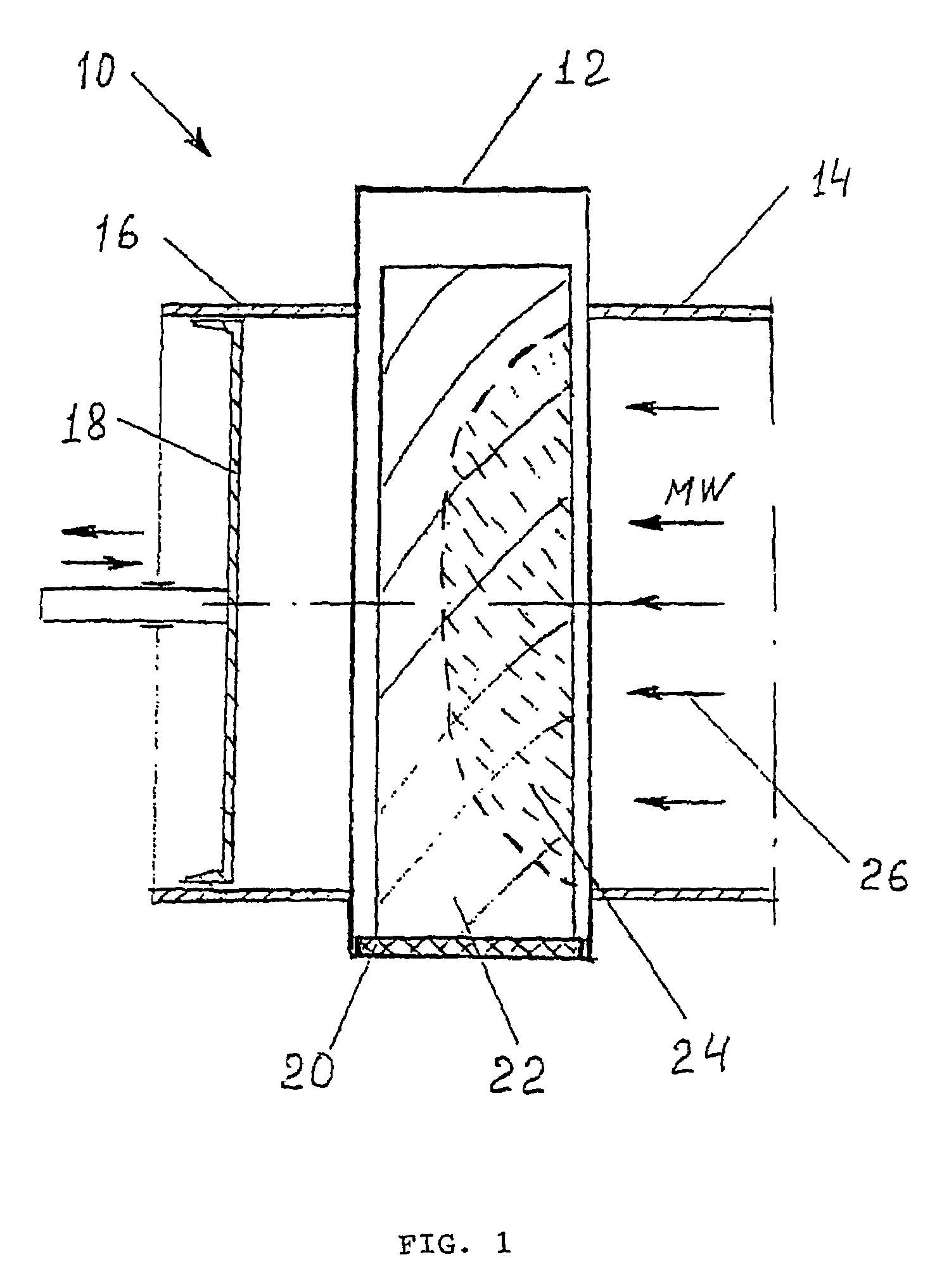Method of microwave treatment of wood
a microwave treatment and wood technology, applied in the field of wood treatment, can solve the problems of reducing the strength properties of wood by 6–25%, requiring high pressure steam, and unable to be used as an exposed surface, and achieve the effect of increasing permeability
- Summary
- Abstract
- Description
- Claims
- Application Information
AI Technical Summary
Benefits of technology
Problems solved by technology
Method used
Image
Examples
example 1
[0053]This Example relates to the microwave pre-treatment of Messmate parquet boards of cross section 25×92 mm for subsequent fast drying in a convectional kiln. One side of the boards must have high hardness and minimum drying defects in the surface layers. Initial wood moisture content was 90%.
[0054]For pre-treatment the board was placed on a conveyer belt 20 as shown on FIG. 1 and moved along the tunnel 12. Microwave energy was supplied to the timber through the waveguide 14 as shown by arrows 26. Process parameters: microwave frequency —0.922 GHz, electric field strength vector E orientation—parallel to wooden grain, average power intensity 280 W / cm2, conveyor speed—6.3 mm / s.
[0055]Microwave irradiation required to vaporise water contained in a zone of the external shell of the wood and to create internal pressure and a temperature above 100° C. in that zone of the wood was applied resulting in modification of the wood structure by destroying ray cell tissue and by formation of p...
example 2
[0058]This Example relates to the microwave pre-treatment of Messmate boards of cross section 45×120 mm for following fast drying in a convectional kiln. The boards must have minimum bending strength losses on the application of vertical load. Only the central region of the timber can be modified. Initial wood moisture content was 90%.
[0059]For microwave pre-treatment the board was placed on the conveyer belt 36 as shown on FIG. 2 and moved along the tunnel 30. Microwave energy was suppled to timber through four waveguide radiators 32 as shown by arrows 34. Process parameters: microwave frequency—2.45 GHz, electric field strength vector E orientation—perpendicular to wooden grain, average power intensity at every waveguide—970 W / cm2, conveyor speed—2.5 mm / s. Microwave irradiation required to vaporise water contained in zones of the external shell of the wood and to create internal pressure in that zone of the wood was applied resulting in modification of wood structure by destroying...
example 3
[0061]This Example relates to the microwave pre-treatment of Messmate lumber of cross section 90×90 mm for subsequent rapid drying in a convectional kiln. The block must have minimum bending strength losses on the application of vertical load. Initial wood moisture content was 90%.
[0062]For microwave pre-treatment the lumber was placed on the conveyer belt 48 as shown on FIG. 3 and moved along the tunnel 44. Microwave energy was suppled to the lumber through the waveguide radiators 46 and c58 as shown by arrows 54 and 56.
[0063]Process parameters of the first stage of the treatment (FIG. 3A) with waveguides 54: microwave frequency supplied in waveguides 54—2.45 GHz, electric field strength vector E orientation in waveguides 54—perpendicular to wooden grain, average power intensity 2,900 W / cm2, conveyor speed—7 mm / s.
[0064]Process parameters of the second stage of the treatment (FIG. 3B) with waveguide 58: microwave frequency supplied in waveguide 58—0.922 GHz, electric field strength ...
PUM
 Login to View More
Login to View More Abstract
Description
Claims
Application Information
 Login to View More
Login to View More - R&D
- Intellectual Property
- Life Sciences
- Materials
- Tech Scout
- Unparalleled Data Quality
- Higher Quality Content
- 60% Fewer Hallucinations
Browse by: Latest US Patents, China's latest patents, Technical Efficacy Thesaurus, Application Domain, Technology Topic, Popular Technical Reports.
© 2025 PatSnap. All rights reserved.Legal|Privacy policy|Modern Slavery Act Transparency Statement|Sitemap|About US| Contact US: help@patsnap.com



